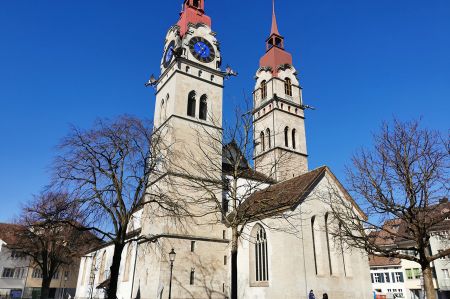The City Church of Winterthur - seven main phases
- Written by Portal Editor
Almost in the center of Winterthur is one of the oldest surviving buildings in the city, the city church, whose building history can be divided into seven main phases between the early Middle Ages and the Reformation.
We had already passed the sacred building, simply called "Stadtkirche", a few times, and now we should also visit the interior extensively.
First foundations of the town church from the 7th/8th century
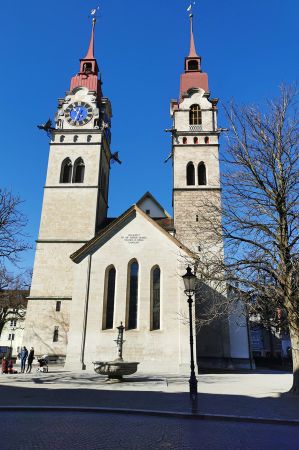 In the 7th/8th In the 19th century, a simple wooden hall was built on a small elevation near the burial ground on the Roman road to the former Vitudurum fort. Posts, as excavations have shown, surrounded a nave nine meters long and six meters wide, to which a narrow chancel was attached to the east. In the 9th century the wooden church was replaced by a solid building that had the same floor plan but was a third longer. Around the year 1000, extensions were added in the north and south, probably as burial places for a local noble family that cannot be identified due to a lack of written sources.
In the 7th/8th In the 19th century, a simple wooden hall was built on a small elevation near the burial ground on the Roman road to the former Vitudurum fort. Posts, as excavations have shown, surrounded a nave nine meters long and six meters wide, to which a narrow chancel was attached to the east. In the 9th century the wooden church was replaced by a solid building that had the same floor plan but was a third longer. Around the year 1000, extensions were added in the north and south, probably as burial places for a local noble family that cannot be identified due to a lack of written sources.
In the late 11th or 12th century the church was completely demolished in order to build a Romanesque hall church with an aisle-like extension to the south. In 1146 Bernhard von Clairvaux visited the church in Winterthur and preached to the people there, as can be seen from the travelogue of his companions. The first documented mention can be found in 1180, when the Bishop of Constance, Berthold, settled a dispute between the priests of Oberwinterthur and Count Hartmann III. von Kyburg settled. North of the chancel, the church was later given a tower and next to it an ossuary, also in the style of a side aisle. From the 13th century there were three naves.
City Church – enlargement of the side aisles
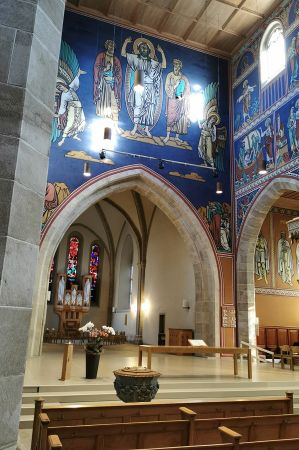 Next to the tower, the oldest part that still exists today is the Romanesque-early Gothic chancel, built around the middle of the 13th century. It was created in the extension of the central nave, based on the model of the Fraumünster in Zurich. Heavy damage in the town fire of 1313 made conversions necessary. With the enlargement of the two side aisles in the 14th century, the town church received a new look. After the Laurentiuskirche was the Kyburg and Neu-Kyburg church until the beginning of the 14th century, the citizens received more and more rights, up to church sovereignty in the 15th century. The urban upper class donated side altars at this time.
Next to the tower, the oldest part that still exists today is the Romanesque-early Gothic chancel, built around the middle of the 13th century. It was created in the extension of the central nave, based on the model of the Fraumünster in Zurich. Heavy damage in the town fire of 1313 made conversions necessary. With the enlargement of the two side aisles in the 14th century, the town church received a new look. After the Laurentiuskirche was the Kyburg and Neu-Kyburg church until the beginning of the 14th century, the citizens received more and more rights, up to church sovereignty in the 15th century. The urban upper class donated side altars at this time.
The seventh and most recent construction phase is then documented by sources. The number of parishioners increased, but on the other hand representation was an important concern for the council. A second tower was built between 1486 and 1490 on the south side of the chancel. The nave was built between 1501 and 1518. It reached ten meters further to the west, but was somewhat narrower than before. After the Reformation, the interior was redesigned in several stages. The ossuary disappeared in 1792, the former sacristy north of the choir was cleared in 1852. The windows of the nave were replaced by neo-Gothic windows by Max Ainmiller in 1853-1856. A cemetery belonging to the church was closed in 1826.
Towers, clocks and bells of the town church
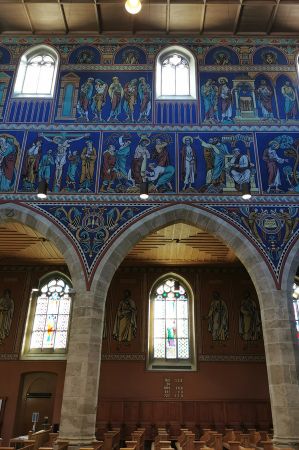 The oldest traces of the north tower, which was still standing at the time, date from 1180 to 1362. From 1486 to 1490 the south tower was added, which received two bells in 1490/1494, which are no longer preserved. The north tower was given its present form in the 16th century, the foundations of the older tower walls are still intact. In 1630, the smaller south tower received its first sundial, in 1659 it was raised to 55 m (although it was now larger), the previous Käsbissen tower was replaced by today's baroque dome. In addition, the tower received dragon gargoyles at the corners and a clock by the Winterthur clockmaker Tobias Liechti. In 1842, the watch received a Munich movement, which was replaced again in 1853 and finally replaced in 1923 by today's electric movement. Almost a hundred years after the addition of a storey to the south tower, the north tower was adjusted in 1794 at the level of the south tower and a baroque hood was also added to it, giving the towers their current appearance. In 1823 the south tower received its second, lower sundial.
The oldest traces of the north tower, which was still standing at the time, date from 1180 to 1362. From 1486 to 1490 the south tower was added, which received two bells in 1490/1494, which are no longer preserved. The north tower was given its present form in the 16th century, the foundations of the older tower walls are still intact. In 1630, the smaller south tower received its first sundial, in 1659 it was raised to 55 m (although it was now larger), the previous Käsbissen tower was replaced by today's baroque dome. In addition, the tower received dragon gargoyles at the corners and a clock by the Winterthur clockmaker Tobias Liechti. In 1842, the watch received a Munich movement, which was replaced again in 1853 and finally replaced in 1923 by today's electric movement. Almost a hundred years after the addition of a storey to the south tower, the north tower was adjusted in 1794 at the level of the south tower and a baroque hood was also added to it, giving the towers their current appearance. In 1823 the south tower received its second, lower sundial.
In 1869, the church was given a five-part bell by Johann Jakob Keller, which is distributed over both towers. The two large bells hang in the south tower, the others in the north tower.
Bell 1 weighs 3999 kg and strikes a°
Bell 2 weighs 2005 kg and strikes cis'
Bell 3 weighs 1170 kg and strikes e'
Bell 4 weighs 496 kg and strikes a'
Bell 5 weighs 255 kg and has the striking note "cis"
The murals by Paul Zehnder
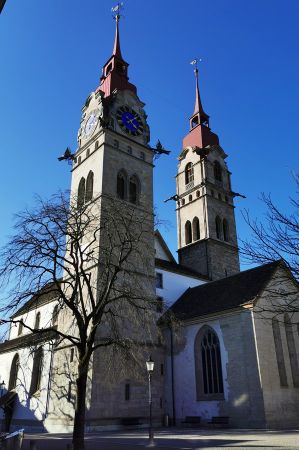 The nave originally contained rich furnishings that were removed during the Reformation together with the organ of the time. In 1644 the pulpit, originally in the middle of a rood screen, was moved to the first south pillar. Today's pulpit is by Ferdinand Stadler and was made in 1854 by a sculptor named Egger from Konstanz. One of the oldest relics in the church is the baptismal font by Hans Conrad Frei from 1656. In 1712 a wooden ceiling decorated with flat carvings was replaced by a plaster ceiling, which in turn was replaced by a coffered ceiling in 1913.
The nave originally contained rich furnishings that were removed during the Reformation together with the organ of the time. In 1644 the pulpit, originally in the middle of a rood screen, was moved to the first south pillar. Today's pulpit is by Ferdinand Stadler and was made in 1854 by a sculptor named Egger from Konstanz. One of the oldest relics in the church is the baptismal font by Hans Conrad Frei from 1656. In 1712 a wooden ceiling decorated with flat carvings was replaced by a plaster ceiling, which in turn was replaced by a coffered ceiling in 1913.
The Romanesque interior painting of the church by Paul Zehnder was created between 1923 and 1930. Both prophets of the Old Testament are depicted on the walls of the aisles and scenes from the New Testament in the central nave. In the Transfiguration scene above the chancel arch, Christ is standing on Mount Tabor between Elijah (with the book) and Moses (with the Tablet of the Law).
A tombstone from the pre-Reformation period is that of Elisabeth von Bach († 1519), a southern German noblewoman and patron of the city. Another grave slab of Magdalena von Fulach (1587-1650), which was discovered during the renovation in 1923, is considered lost. During tours, you can still see the preserved remains of the superstructures dating back to the 9th century, as well as Hans Haggenberg's coat of arms painting from 1493.
Organ of the town church by Karl Joseph Riepp
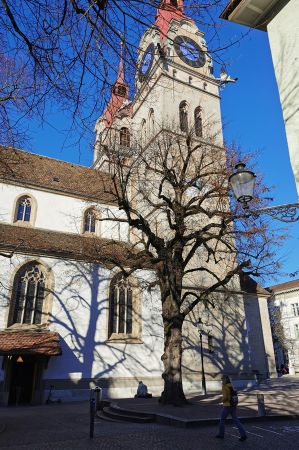 In 1809, the Stadtkirche was the first church in the canton of Zurich to have an organ again. This was donated to the church by the Musikkollegium and originally came from the Salem monastery and was built by Karl Joseph Riepp between 1766 and 1768. The prospectus for this comes from Joseph Anton Feuchtmayer. Since 1888 there has been a Walcker organ with 56 registers, 3 manuals and pedal keyboard in the case of the original organ, in which registers from the previous instrument were reused.
In 1809, the Stadtkirche was the first church in the canton of Zurich to have an organ again. This was donated to the church by the Musikkollegium and originally came from the Salem monastery and was built by Karl Joseph Riepp between 1766 and 1768. The prospectus for this comes from Joseph Anton Feuchtmayer. Since 1888 there has been a Walcker organ with 56 registers, 3 manuals and pedal keyboard in the case of the original organ, in which registers from the previous instrument were reused.
Please read as well:
Winterthur – a Swiss city through the ages
Archaeological Excavations of the settlement of Siculi in 2015
-
 Stadtkirche Winterthur - quite old Building
Stadtkirche Winterthur - quite old Building
Stadtkirche Winterthur - quite old Building
Stadtkirche Winterthur - quite old Building
-
 Stadtkirche Winterthur - quite old Building
Stadtkirche Winterthur - quite old Building
Stadtkirche Winterthur - quite old Building
Stadtkirche Winterthur - quite old Building
-
 Stadtkirche Winterthur - quite old Building
Stadtkirche Winterthur - quite old Building
Stadtkirche Winterthur - quite old Building
Stadtkirche Winterthur - quite old Building
-
 Stadtkirche Winterthur - quite old Building
Stadtkirche Winterthur - quite old Building
Stadtkirche Winterthur - quite old Building
Stadtkirche Winterthur - quite old Building
-
 Stadtkirche Winterthur - quite old Building
Stadtkirche Winterthur - quite old Building
Stadtkirche Winterthur - quite old Building
Stadtkirche Winterthur - quite old Building
-
 Stadtkirche Winterthur - quite old Building
Stadtkirche Winterthur - quite old Building
Stadtkirche Winterthur - quite old Building
Stadtkirche Winterthur - quite old Building
https://www.alaturka.info/en/switzerland/zurich/5580-the-city-church-of-winterthur-seven-main-phases?tmpl=component&print=1&layout=default#sigProIda482142137
